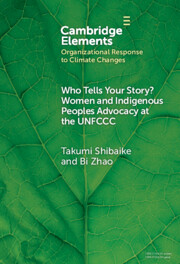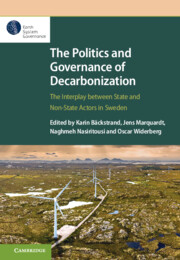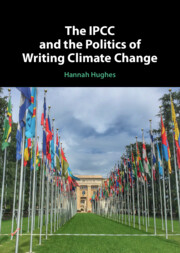Refine search
Actions for selected content:
51 results
3 - Climate Scenarios: A Tale of Three Futures
-
- Book:
- From Crisis to Action
- Published online:
- 15 August 2025
- Print publication:
- 04 September 2025, pp 44-73
-
- Chapter
-
- You have access
- Open access
- HTML
- Export citation
12 - International Law
- from Part III - Regime Interaction and Interpretation
-
-
- Book:
- The Cambridge Handbook on Climate Litigation
- Published online:
- 03 June 2025
- Print publication:
- 31 July 2025, pp 301-319
-
- Chapter
-
- You have access
- Open access
- HTML
- Export citation
15 - State Responsibility
- from Part IV - Liability and Evidence
-
-
- Book:
- The Cambridge Handbook on Climate Litigation
- Published online:
- 03 June 2025
- Print publication:
- 31 July 2025, pp 371-390
-
- Chapter
-
- You have access
- Open access
- HTML
- Export citation
9 - (Non)Governance Evolving
-
-
- Book:
- Governing Climate Change Loss and Damage
- Published online:
- 10 June 2025
- Print publication:
- 26 June 2025, pp 177-198
-
- Chapter
-
- You have access
- Open access
- HTML
- Export citation
1 - Introduction
-
-
- Book:
- Governing Climate Change Loss and Damage
- Published online:
- 10 June 2025
- Print publication:
- 26 June 2025, pp 1-24
-
- Chapter
-
- You have access
- Open access
- HTML
- Export citation
4 - Knowledge Politics on the Frontlines
-
-
- Book:
- Governing Climate Change Loss and Damage
- Published online:
- 10 June 2025
- Print publication:
- 26 June 2025, pp 70-90
-
- Chapter
-
- You have access
- Open access
- HTML
- Export citation
10 - Conclusion
-
-
- Book:
- Governing Climate Change Loss and Damage
- Published online:
- 10 June 2025
- Print publication:
- 26 June 2025, pp 199-222
-
- Chapter
-
- You have access
- Open access
- HTML
- Export citation
Recognising differentiated affectedness within a global demos: promoting the democratic legitimacy of the UNFCCC
-
- Journal:
- Global Constitutionalism , First View
- Published online by Cambridge University Press:
- 10 February 2025, pp. 1-28
-
- Article
-
- You have access
- Open access
- HTML
- Export citation

Who Tells Your Story?
- Women and Indigenous Peoples Advocacy at the UNFCCC
-
- Published online:
- 07 February 2025
- Print publication:
- 13 February 2025
-
- Element
- Export citation

The Politics and Governance of Decarbonization
- The Interplay between State and Non-State Actors in Sweden
-
- Published online:
- 05 December 2024
- Print publication:
- 28 November 2024
-
- Book
-
- You have access
- Open access
- Export citation
7 - The Politics of Approval
-
- Book:
- The IPCC and the Politics of Writing Climate Change
- Published online:
- 04 July 2024
- Print publication:
- 31 October 2024, pp 125-157
-
- Chapter
-
- You have access
- Open access
- HTML
- Export citation
1 - Introduction
-
- Book:
- The IPCC and the Politics of Writing Climate Change
- Published online:
- 04 July 2024
- Print publication:
- 31 October 2024, pp 1-12
-
- Chapter
-
- You have access
- Open access
- HTML
- Export citation
8 - Concluding on the Meaning and Implications of Writing Climate Change
-
- Book:
- The IPCC and the Politics of Writing Climate Change
- Published online:
- 04 July 2024
- Print publication:
- 31 October 2024, pp 158-170
-
- Chapter
-
- You have access
- Open access
- HTML
- Export citation
3 - Situating the IPCC as a Practice of Writing
-
- Book:
- The IPCC and the Politics of Writing Climate Change
- Published online:
- 04 July 2024
- Print publication:
- 31 October 2024, pp 30-45
-
- Chapter
-
- You have access
- Open access
- HTML
- Export citation

The IPCC and the Politics of Writing Climate Change
-
- Published online:
- 04 July 2024
- Print publication:
- 31 October 2024
-
- Book
-
- You have access
- Open access
- Export citation
6 - Energy and Green Technologies
-
- Book:
- Energy and the Environment
- Published online:
- 30 April 2024
- Print publication:
- 02 May 2024, pp 222-266
-
- Chapter
- Export citation
7 - More Resources – More Influence of International Bureaucracies?
-
-
- Book:
- International Public Administrations in Environmental Governance
- Published online:
- 22 February 2024
- Print publication:
- 29 February 2024, pp 153-179
-
- Chapter
-
- You have access
- Open access
- HTML
- Export citation
3 - The Evolution of International Environmental Bureaucracies
-
-
- Book:
- International Public Administrations in Environmental Governance
- Published online:
- 22 February 2024
- Print publication:
- 29 February 2024, pp 57-72
-
- Chapter
-
- You have access
- Open access
- HTML
- Export citation
8 - The Marrakech Partnership for Global Climate Action
-
-
- Book:
- International Public Administrations in Environmental Governance
- Published online:
- 22 February 2024
- Print publication:
- 29 February 2024, pp 180-200
-
- Chapter
-
- You have access
- Open access
- HTML
- Export citation
7 - Beyond Negotiations
- from Part II - Navigating Sites
-
-
- Book:
- Conducting Research on Global Environmental Agreement-Making
- Published online:
- 07 August 2023
- Print publication:
- 10 August 2023, pp 121-140
-
- Chapter
- Export citation
